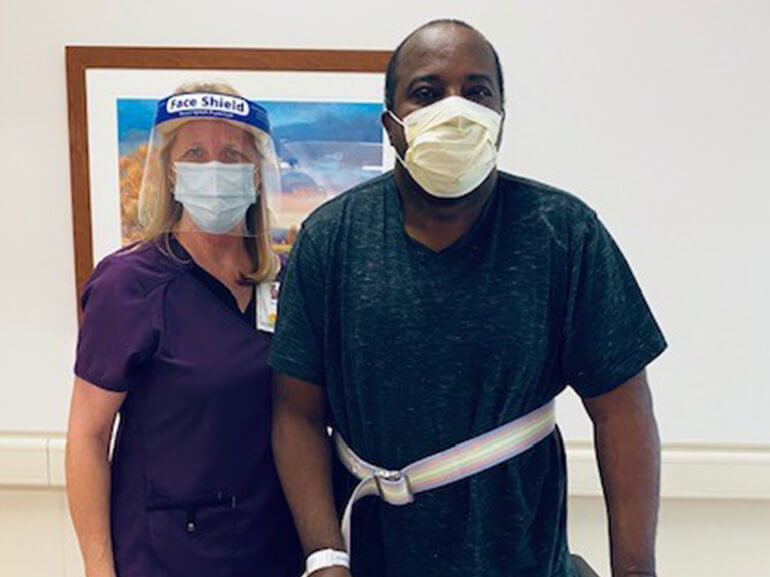Vance's story

Vance Stevenson, 55, lived an active and family-focused life in north central Florida. When he was not working full-time as a custodian, Vance loved singing at church, reading, writing and spending time with his family, including his 14 grandchildren. Vance noticed a wound on his lower leg that would not heal. He spent the next year dealing with unrelenting pain and hospital visits, seeking options to avoid an amputation. His pain limited his life immensely.
Vance’s physician explained if his leg was not amputated, he would likely get gangrene, a dangerous and potentially fatal condition that happens when the blood flow to a large area of tissue is cut off, causing the tissue to break down and die. Vance and his wife were concerned about the thought of amputation; they had never known anyone who had a limb amputated and were unsure about what it would mean for Vance’s future. As they considered their options, they began to notice other amputees on TV and around them that made them realize there was quality life after amputation. Seeing other successful amputees was “God’s ways of saying that he’d be OK,” Vance’s wife said.
Vance decided to proceed with the amputation of his left leg below the knee. After the procedure, Vance was admitted to UF Health Rehab Hospital to begin his recovery. Upon arrival, Vance’s short-term goals were to be more independent in his mobility and his self-care, while his long-term goals were to get a prosthesis and re-learn to walk so that he could more easily play with his grandkids and go out with his wife again.
His physician-led team of nurses and physical, occupational and speech therapists formed a plan to help Vance work toward achieving his goals.
In occupational therapy, Vance worked with therapists on gaining strength, safely transferring from sitting to standing, improving his upper body range of motion, standing tolerance and performing personal care. In his occupational therapy group, he worked with patients with the similar goals in a space that allowed interaction, connection and mutual encouragement. Both his occupational therapists and recreation therapists challenged Vance to Wii bowling battles, further challenging him to work on standing tolerance. Physical therapists helped Vance to improve his endurance and mobility while providing education to both him and his wife on how to prepare for his safe return home. In speech therapy, therapists assisted Vance with exercises for his memory and helped with his medication management. His therapists noted that Vance was always willing to participate and put in the work needed to meet his goals.
After just over two weeks at UF Health Rehab Hospital, Vance made great strides in improving his strength and mobility. He was able to eat and perform personal care independently, only requiring supervision for bathing, some transfers and walking short distances with a walker. Vance’s wife says that the training she received at the hospital made her more confident in helping him make his return home.
Unfortunately, at a follow-up doctor’s appointment, Vance learned that further infection has set in requiring him to get more of his leg removed. Although it was another detour in his journey, that did not stop Vance.
He returned to UF Health Rehabilitation Hospital after receiving his prosthetic leg to undergo prosthetic training and additional therapy. During this stay, physical therapists utilized the Tollos, a therapy device where the patient gets in a harness to support body weight while helping to train the patient to stand, do standing activities and walk. Vance raved about how helpful the Tollos was for him. In the gym during a therapy session, Vance demonstrated to a group of new amputees how to take off and put on his prosthetic. During Vance’s second stay at the hospital, he also showed off his skills by dominating a corn hole tournament. Vance says that he enjoyed all of his therapies and that his experience taught him to take nothing for granted.
"Vance is an incredibly hard worker with a kind heart. He was always up for any task, or exercise I threw at him with no hesitation,” said his physical therapist. “He also provided mentorship to some of our more acute amputee patients in regard to getting a prosthesis for the lower extremity and demonstrated how to put on and remove the device. Vance will continue to do well out in the community and is a role model to fellow amputee patients."
By the time Vance was ready to return home again, he was able to walk over 150 feet with a walker with minimal assistance, navigate stairs with minimal assistance and was independent in his self-care (including putting on and taking of prosthetic) and transfers.
Vance is thankful for his wife’s role in his recovery, saying, “My wife has been with me through thick, thin, and suffering. She would always comfort me, bring me food when I was down and remind me that things would be alright. She did family training and when I discharged the first time, she helped me with dressing and anything else I needed. Family training was helpful, helping us to be more prepared going home.”
Vance’s advice for anyone undergoing intensive rehabilitation for amputation is to “be who you are, motivate yourself and condition your mind. There will be bumps and bruises but overall, it’s worth the challenge.”
Vance and his wife want individuals who may be facing or have undergone an amputation to know that you can still live a full life after limb loss. “Just because you lost a limb doesn’t mean you lost your life,” Vance said. He looks forward to driving, getting back to his previous leisure activities and returning to the “old Vance” again.
*Patient success stories from across our hospital network.